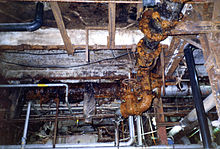A paper mill is a factory devoted to making paper from vegetable fibres such as wood pulp, old rags and other ingredients using a Fourdrinier machine or other type of paper machine
History
See also: History of paper
Historical investigations into the origin of the paper mill are complicated by differing definitions and loose terminology from modern authors. Many scholars use the term to refer to all kinds of mills, whether powered by humans, by animals or by water. However, the propensity of these authors to refer indiscriminately to any ancient paper manufacturing centre as a "mill", without further specifying its exact power drive, has increased the difficulty of identifying the particularly efficient water-powered type.
Human and animal-powered mills
Evidence for water-powered paper mills is elusive in both Chinese and Muslim papermaking, while the use of human and animal powered mills were known to them. The general absence of the use of water-power in Muslim papermaking is suggested by the habit of Muslim authors to call a production center a "paper manufactory", but not a "mill".
Scholars have identified "paper mills" in Abbasid-era Baghdad in 794-795, though the evidence that waterpower was applied to papermaking at this time is a matter of scholarly debate. In the Moroccan city of Fez, Ibn Battuta speaks of "400 mill stones for paper". Since Ibn Battuta does not mention the use of water-power and such a number of water-mills would be grotesquely high, the passage is generally taken to refer to human or animal force instead.
Water-powered mills
An exhaustive survey of milling in Al-Andalus did not uncover a single water-powered paper mill, nor do the Spanish books of property distribution (Repartimientos) after the Christian reconquest refer to any. Arabic texts never use the term mill in connection with papermaking and the most thorough account of Muslim papermaking, the one by the Zirid Sultan Al-Muizz ibn Badis, describes the art purely in terms of a handcraft. Donald Hill has identified a possible reference to a water-powered paper mill in Samarkand, in the 11th-century work of the Persian scholar Abu Rayhan Biruni, but concludes that the passage is "too brief to enable us to say with certainty" that it refers to a water-powered paper mill. While this is seen by Halevi nonetheless as evidence of Samarkand first harnessing waterpower in the production of paper, he concedes that it is not known if waterpower was applied to papermaking elsewhere across the Islamic world at the time; Robert I. Burns remains altogether sceptical given the isolated occurrence of the reference and the prevalence of manual labour in Islamic papermaking elsewhere.
Stromer's paper mill, the building complex at the far right bottom, in the Nuremberg Chronicle of 1493. Due to their noise and smell, papermills were required by medieval law to be erected some distance from the city walls.
Hill notes that paper mills appear in early Christian Catalonian documentation from the 1150s, which may imply Islamic origins, but here too hard evidence is lacking, and the case for early Catalan water-powered paper mills has been thoroughly dismissed after a re-examination of the evidence cited by Burns. Likewise, the identification of early hydraulic stamping mills in medieval documents from Fabriano, Italy, is completely without substance.
The earliest certain evidence to a water-powered paper mill dates to 1282 in the Spanish Kingdom of Aragon. A decree by the Christian king Peter III addresses the establishment of a royal "molendinum", a proper hydraulic mill, in the paper manufacturing centre of Xàtiva. The crown innovation appears to be resented by the local Muslim papermakering community; the document guarantees the Muslim subjects the right to continue their way of traditional papermaking by beating the pulp manually and grants them the right to be exempted from work in the new mill.
The first permanent paper mill north of the Alpes was established in Nuremberg by Ulman Stromer in 1390; it is later depicted in the lavishly illustrated Nuremberg Chronicle. From the mid-14th century onwards, European paper milling underwent a rapid improvement of many work processes.
Characteristics
Main articles: Pulp mill and Paper machine
Paper mills can be fully integrated mills or nonintegrated mills. Integrated mills consist of a pulp mill and a paper mill on the same site. Such mills receive logs or wood chips and produce paper. It is a common misconception that paper mills are sources of odors. Pulp mills and the pulping section of integrated mills (particularly if using the kraft process) commonly have associated odors; nonintegrated mills purchase wood pulp, usually in dry bales known as market pulp, and produce little, if any, odor.
The modern paper mill uses large amounts of energy, water, and wood pulp in a highly efficient and extremely complex series of processes, using modern and sophisticated controls technology to produce a sheet of paper that can be used in incredibly diverse ways. Modern paper machines are very large and can be 500 feet (~150 m) in length, produce a sheet 400 inches (~10 m) wide, and operate at speeds of more than 60 mph (100 km/h). The two main suppliers of paper machines are Metso and Voith.
(source:wikipedia0



No comments:
Post a Comment